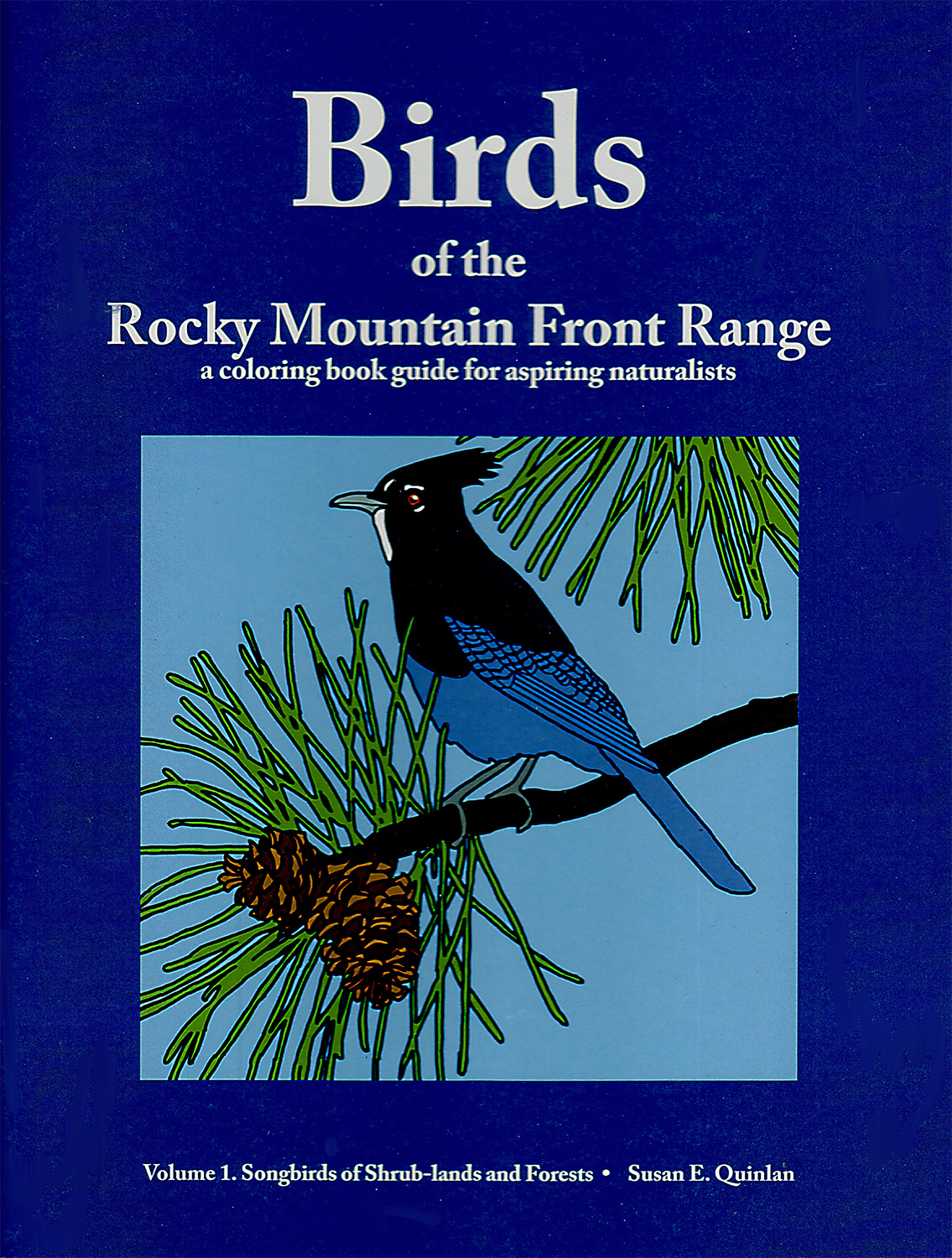
15% Discount on books, cards, and art from my online store.
No worries!! I'll only send occasional updates. And I promise to never share your email address with anyone for any reason.

No worries!! I'll only send occasional updates. And I promise to never share your email address with anyone for any reason.

Every day the news seems to get more alarming and depressing. North American bird populations have decreased by nearly 3 billion birds in the past 50 years. Insects are dying out worldwide—there’s an insect apocalypse! Greenland lost an unimaginable 2,200 gigatons of ice in the years between 2010 and 2018 alone. Most recently, huge swaths of Australia were on fire-the koalas and kangaroos dying; cockatoos were falling dead from the skies. I won’t even mention current political situations, in the United States, and worldwide.
All of this is alarming, heart-wrenching, over-whelming, scary, and yes, quite depressing.
For those of us who care about wildlife and understand how our own futures, personally and as a species, are intertwined with all of nature, these events feel devastating. How can any of us maintain hope in the face of so much terrible news about events that we are individually helpless to change?
I’d be lying if I said I do not feel depressed by what is happening around the world. There have been days I have just wanted to stay in bed and hide under the covers – forever.
But that isn’t exactly a workable solution to the problems, or my depression about them. So to help myself keep functioning, I have sought out ways to help myself fight off despair and find hope. Suspecting that others likely share my feelings, I thought it might be helpful to share the top five methods I use to help myself. Possibly they might help you, too.
The news media focuses on disasters and negative news because heart-stopping stories apparently attract more readers. Headlines often exaggerate a situation specifically to attract attention and the appended text and photos may only tell the worst parts of the full story.

Four months of listening to the news transformed the world into a very scary place. Image by Jan Mallander from Pixabay
This constant exposure to negative news can create a sense that things are much worse than reality. In my early 20’s, while studying seabirds for my Master’s degree, I lived in a tent camp on a remote island, with only two other people, for four summer months. That fall, when I returned to “civilization” in Fairbanks, Alaska, I was surprised by strong feelings of fear at being around lots of strange people again-especially at night or in town.
As I reflected on what was causing this new fear, I realized that for the previous four months, my only contact with the rest of the world had been via a.m. radio. For months, I had heard all about all the bad news—the murders, rapes, robberies, disasters, and other terrible events happening in Alaska and around the world. Fortunately, it didn’t take long for the actual rarity of such events in Fairbanks to alleviate the unwelcome anxiety I felt the first couple months after my re-entry to the populated world.
That experience taught me to remember that the news continually presents a negatively skewed picture of what is happening in the world. Many good things and most neutral things aren’t reported at all, but these are also happening everywhere, all the time too.
One way to keep all the negative news in perspective is to just not read it daily—I try to take frequent breaks from filling my mind with the bad news. It isn’t possible to completely avoid the news, and I feel a need to be informed about what is happening in the world, so I do read and listen to the news. But I also try to limit my exposure to it.
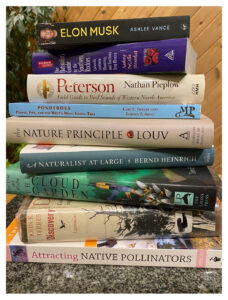
So much to read, so little time.
Instead of checking the headlines of the newspapers every morning, I try to make progress reading through the the tall stack of books next to my bed, and the other titles on waiting on my iPad. I also recently discovered “Feedly” —a helpful app that brings to my screen the headlines and stories from a mixture of blogs and magazines I personally selected as of interest to me. Now I start more of my mornings reading science articles about ecology and discoveries about interesting plants, animals and places instead of news about the latest disasters and political uproars.
Instead of listening to the news on the car radio as I drive, I try to listen to podcasts or audiobooks. I find my time better spent and my mood much improved after listening to a book like “The Soul of an Octopus” by Sy Montgomery, a Ted Talk by George Montbiot, or a motivational cd by Jack Canfield. Learning new information about just about any topic other than current events is far more nourishing to my mind and spirit than reading about the latest political storm or human tragedy. Whatever new knowledge I acquire provides something besides the bad news for my mind to reflect upon. Thus the benefit of this change in habit extends well past the listening.
Keeping in mind the negative slant of news stories, I also find it is often helpful to dig up the facts behind the news, especially when the news about nature is deeply distressing. Learning more about the source of the news story and the actual facts and research behind the headlines is sometimes helpful.
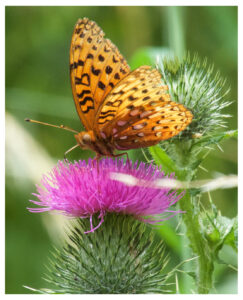
Are insects disappearing everywhere?
For example, when I first read about the “Insect Apocalypse,” the news stories were terrifying—insect populations all over the world have decreased by more than 40% several different news stories proclaimed. That seemed so shocking, I immediately wondered what data these dire proclamations were based on. So I searched out and read more stories about the subject until I found the source of the apocalyptic proclamations traced back to relatively few studies—one, a long term study in Germany, and the other a large review of the literature which identified several studies from North America and Europe that reported similar declines in insect populations. (More info here)
While these reports are alarming, I know it doesn’t make a lot of sense to extrapolate from these limited studies to the entire world and insect populations everywhere. Yes, there is worrying corroborating evidence from other available information, including monarch butterfly censuses and my own personal observations and recollections of insect numbers over the decades. But the reality seems to not be quite as bad as the first headlines and reports I had read suggested.
This realization quelled some of my gut-wrenching fear that most of the insect diversity on our planet is rapidly disappearing for unknown reasons. Many reasons do exist for heightened concern about insect populations. And we must recognize that invertebrate conservation is as important as protecting large, popular animals, like eagles, tigers, and whales. But panic, despair, and hiding under the covers won’t help bring about the necessary changes. Plus, reasons to believe we can change the situation exist, which brings me to my next antidote to despair.
Certainly it takes some searching to find good news, but there are lots of hope-inducing stories out there. Individuals and organizations all around the world are working hard to find creative ways to conserve and restore nature—and there are some remarkable successes and reasons for hope.
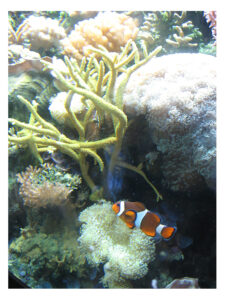
Scientists are finding interesting ways to help protect and restore coral reefs.
For example, scientists around the world are seeking, and finding, creative ways to fight back against the loss of coral reefs and help to restore them. Did you read about the Brazilian biologists at the Federal University of Rio de Janeiro who discovered certain microbes may be able to help coral reefs ward off and survive higher water temperatures and coral bleaching?
Elsewhere, Australian researchers reported their recent discovery that the recorded sounds from a healthy coral reef attract young fish and other animals to colonize degraded areas of reef. They observed a remarkable increase in the numbers of various fish species attracted to experimental areas when they played underwater recordings during the night. Their research, reported in Nature Communications offers hope of improving the success of coral reef restoration projects.
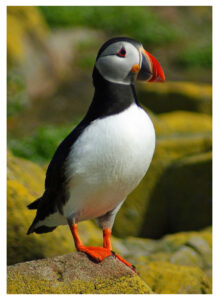
I also find hope in stories of changing attitudes, and increased concerns, about conservation of nature. For example, on Heimey Island in Iceland, islanders used to hunt and kill hundreds of thousands of puffins to eat them for dinner. But as puffin populations have declined due to warming ocean waters and food scarcity, these same people are now working long, hard nights to help lost baby pufflings get out to sea where they will have a better chance at surviving.
I am particularly encouraged by the news that a badly depleted fishery off the west coast of the United States has rebounded to health due to a remarkable cooperative effort between environmentalists and commercial fishermen. Rare though such stories may be, important discoveries and conservation successes are still happening.
In San Francisco, one man took it upon himself to save a disappearing butterfly species. California Academy of Sciences biologist, Tim Wong, converted his own backyard into a garden for the rare California Pipevine Swallowtail. After determining that the caterpillars of these butterflies need a specific kind of plant, the California pipevine, he began planting the vines in his yard to raise caterpillars on them. Over the past few years, Wong has raised thousands of caterpillars on his vines. When the caterpillars metamorphosed into adult butterflies, he released those into suitable habitats around the city, helping the pipevine butterfly return to some areas from which it had previously disappeared. (Read more here.)
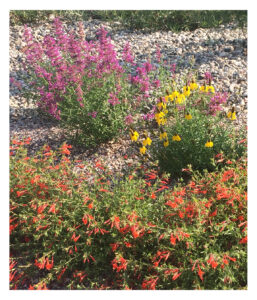
By planting native wildflowers instead of exotic species, we can all help create more habitat for native bees and other insects.
A growing number of people all across the United States are now working to replace their bluegrass lawns and exotic plants with native grasses and flowers to help recreate usable habitat for a wide variety of native insects and birds. A similar movement, called re-wilding, is taking hold in Great Britain and Europe. These trends have the potential to recreate enough interconnected habitat to bring back healthier populations of many insects and birds, just as Wong’s work in San Francisco helped recover a population of the pipevine butterfly.
All these current stories indicate to me that many people around the world care deeply about nature. Concerned individuals are trying to turn the tide on climate change, pollution, habitat destruction, and misuse and overuse of natural resources. I prefer to join with all these people—and do whatever I can to change whatever I can for the better, rather than getting depressed and paralyzed by the seemingly never-ending bad news.
The best news of all is that nature is remarkably resilient.
When I look back at the near-history of wildlife conservation and take note of the many dismal situations which were turned around when people joined together to change what was happening, I find many, many reasons for hope.
In 1942, 78 years ago, the entire population of whooping cranes on Earth had dwindled to only 22 birds. Through the dedicated work of committed biologists and the contributions of many, many people, a wild population of over 500 of these elegant migratory birds exists today. The once great flocks of these giant birds which once sailed high over the prairies in migratory flights back and forth from coastal Texas to interior wetlands of Canada have not yet returned. But these majestic, five foot tall birds with their inimitable whooping calls, remain as a living part of nature. We have far more reasons to hope for a long future for this species than seemed possible a half-century ago.
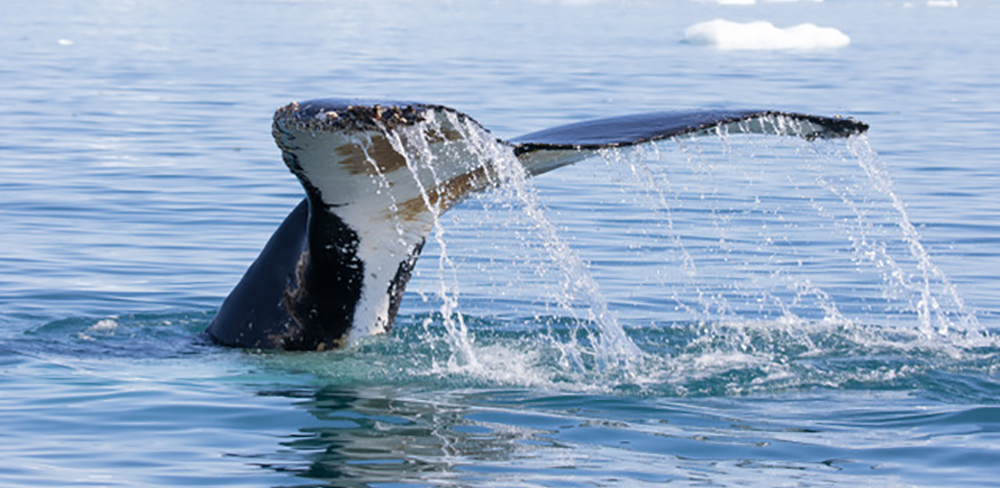
Humpback Whale Populations have recovered in many areas. Photo © Bud Lehnhausen
Humpback Whales were also close to extinction in the 1950s and 60’s because humans had hunted them down in all the oceans of the world. They were killed for their baleen, for meat, and their fat which was turned into oil for heating, lighting and lubrication uses. Due to the collapse of the whaling industry, and international treaties to protect whales, these amazing ocean animals have returned to their former abundance in several regions of the world’s oceans. (More info) Some populations of humpbacks are still in danger of disappearing, but in many areas including the waters of the western North Pacific, the southwestern Atlantic, and the Antarctic Ocean, humpback whales are once more abundant Thousands of people were once employed to kill whales, but today thousands of people pay for the opportunity just to see them. That is a remarkable change.
The fact that we humans have identified problems, changed our behaviors, and taken positive actions to protect and restore populations of disappearing species is evidence that the current dire situation is not hopeless. Our challenges today are greater though. We now know we must find ways to protect and restore not only species, but also habitats, ecosystems, and our entire planet.
To overcome these far more difficult challenges, we must work hard to ensure that more of us understand the values of nature, what we face losing, and how to save and restore as much as possible. Knowing that others have succeeded against the odds in the past to save several species gives me lots of hope that we humans who care can beat the long odds against us once again. But to do so, we must maintain hope and not give up. That requires caring for our own mental health.
For me, the best medicine for depressed feelings is to get outdoors and soak up whatever nature I can find. Getting outside where I can watch clouds jostled by the wind, take deep breaths of air filled with the scents of nature, listen to the songs of wild birds, see tracks or other wildlife sign, and feel the solid wild earth under my feet helps me re-center.
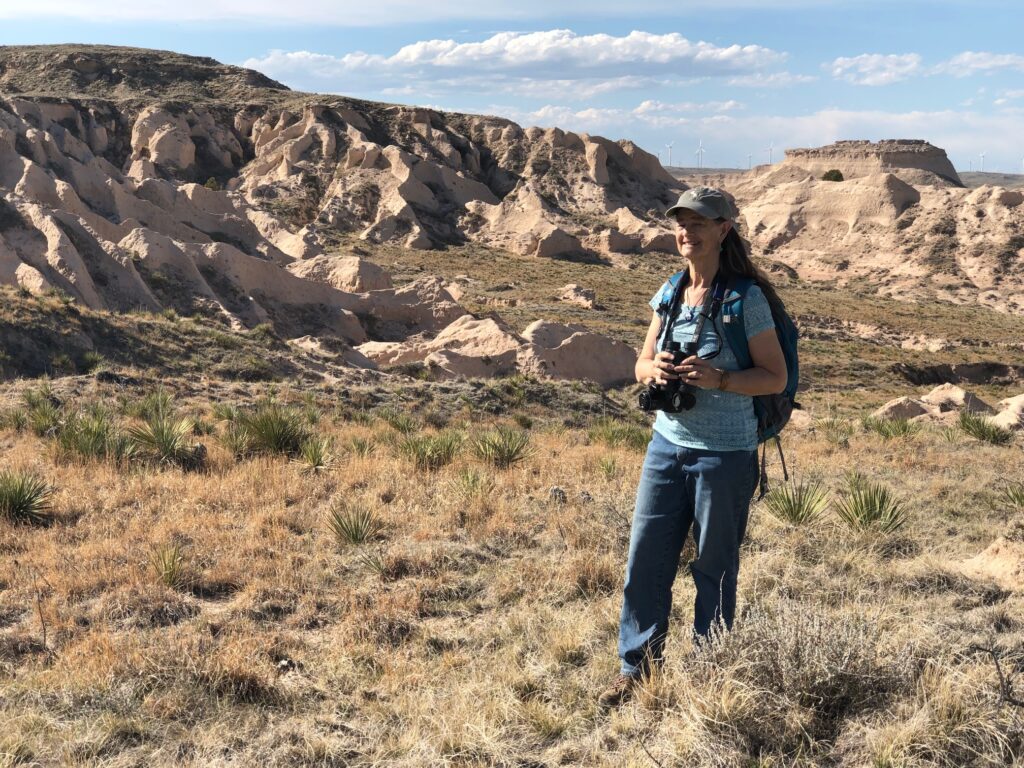
Hiking in Pawnee Buttes National Grassland
Psychologists often speak about the healing power of “mindfulness” — taking deep breaths, being fully aware of the moment you are in, and noticing details about the immediate world around you. For me, that is basically what I do automatically when I am out in nature. If I have hiked any distance, I am likely out of breath due to exertion so I am naturally taking deep breaths to refill my oxygen supplies. So the breathing part of “mindfulness” gets done out of necessity.
I love to carefully observe plants and look for wildlife. I aim to notice patterns in nature. And I seek out microhabitats—sites that offer slightly different conditions which may support different kinds of plants or invertebrates than the primary habitat I am visiting. To achieve these goals requires quieting my mind and my body, to focus more fully on my surroundings. Without previously knowing the psychological term for my behavior, I now see that mindfulness is basically what I do whenever I visit a natural area.
I know not everyone who gets out in nature does this, but many people must, intentionally or unintentionally, because research studies continue to report that humans benefit psychologically from contact with and time spent in nature.
For example, a 2015 study in the Proceedings of the National Academy of Sciences found that people who walked for 90 minutes in a natural environment had fewer repetitive negative thoughts than people who walked the same amount of time in a city. A just released 2020 review from Cornell University reported in Frontiers in Psychology reported that based on fourteen studies conducted in Japan, Sweden and the United States, college students who spent 10 to 20 minutes outdoors in a natural area had healthier blood pressure and heart rates as well as measurable decreases in stress, anxiety, and anger. They also displayed improvements in various measures of happiness. Another recent study in Nature reported evidence that people who spend two hours each week in natural areas enjoy an increased sense of well-being.
As Henry David Thoreau wrote over 150 years ago: “There can be no very black melancholy for he who lives in the midst of nature and has his senses still.”
Outdoors, with the arms of the Earth around me, I can see that despite the many worrying trends and terrible tragedies happening daily, our planet is still a beautiful, amazing place with diverse and remarkably adapted plants, insects, birds, mammals, and fungi. It is a place I want to help others discover and enjoy—and a place that I want to do everything I can to protect for future generations of people.
After a good dousing of nature immersion, I find my racing mind is quieter, my spirit renewed, Wallowing in despair or hiding under the blankets no longer seems an option. Reinvigorated by time spent in nature, I can observe firsthand that whatever our losses are, right now our Earth remains a rich and beautiful place. A great diversity of species and habitats still remain.
But as Dr. Seuss wrote in his book, The Lorax: “Unless someone like you cares a whole awful lot, Nothing is going to get better. It’s not.”
So restored by time in nature, my resolve to make a difference for the future is renewed. And that brings me to the final method I use to fight off despair about our current situation and the difficult challenges ahead.
While we may be individually helpless to change anything immediately, there seems no end to what we can each do personally to affect the future. I aim to be less a part of the problem and more a part of the solution every single day.

Even a small action helps make a difference..
Taking my reusable bags to the store, picking up someone else’s tossed piece of trash, buying organic food, skipping the use of a disposable cup or an extra car trip, walking or riding my bike instead of driving, turning off a faucet or an unneeded light…every small action I take to lessen my environmental footprint helps me feel a little stronger, a little more in control, and a bit more hopeful.
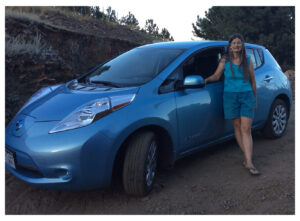
Love being able to drive an all-electric Nissan Leaf powered mostly by our rooftop solar panels.
More expensive actions, like buying and driving an all-electric vehicle and investing in solar panels to power one’s home (and car), are actions I know most people can’t afford to take. But since we could, I felt a moral obligation to do both. These actions have helped me feel more hopeful and more comfortable speaking up to encourage others to do whatever they can.
Alarmed about the need for conservation of birds, insects and other invertebrates? Contributing to worthwhile conservation efforts or organizations is an action that helps me improve my outlook. Why not also skip a cup of coffee or a dinner out, and contribute a few dollars to support organizations that are working for conservation of birds or insects. Two organizations doing good work for bird conservation are the National Audubon Society and the American Bird Conservancy. The Xerces Society and The Butterfly Pavilion, are two organizations doing great conservation and research work for invertebrates. Look to see if there any local organizations near you doing similar work? Perhaps they could use aa contribution or if you don’t have money to donate, perhaps you could volunteer to help?
Overwhelmed by the news of the terrible fires in Australia, why not pitch in to help? Donate to support Bush Heritage Australia—a nonprofit that does important work to protect Australia’s unique biodiversity or some other organization working to help the wildlife and people affected by the recent unprecedented and destructive fires.
One of my favorite organizations to support is Idea Wild! This small non-profit helps local people around the world who are doing frontline nature conservation work around the world—conducting basic wildlife research, helping establish reserves, or working to educate their fellow citizens on the values and beauty of their local environments. By providing committed individuals with equipment they couldn’t otherwise afford–like binoculars, wildlife radio tags, or projectors for presentations–Idea Wild! empowers these people to make a difference for nature wherever they live.
Speaking up for conservation is another actionable antidote to feelings of despair. I have never felt that any letter I wrote to a US Congressperson made any real difference in how any one of them voted, but as my mom always told me: “Hope springs eternal.” Taking a few minutes to write to our legislators about critical issues feels lots better to me than simply doing nothing. So while I don’t write nearly as many letters as I feel I should, I do find some spirit-renewal through writing to protest inaction or bad decisions, and in support of positive legislation.
As frightening and uncertain as the future looks for nature, and us, we still live on an amazing and beautiful planet. Yet time is of the essence. I feel certain we can yet turn things around—but that won’t happen if we just look on and bemoan our mounting losses. Despair is not an option. Changing the situation requires all of us who care, to find and maintain hope, and repeatedly take whatever personal actions we can.
I hope the five steps I use to maintain my own hope might also help you:
1. Turn off the news—learn about interesting subjects instead.
2. Research the facts behind the headlines.
3. Look for good news and remember the resiliency of nature.
4. Get out and enjoy our beautiful natural world.
5. Take personal action, daily.
How Immersion in Nature Benefits Your Health
Reason for Hope – A Spiritual Journey by Jane Goodall
Bringing Nature Home by Doug Tallamy
Rewilding the World by Caroline Fraser
Wilding-Returning Nature to Our Farm by Isabella Tree
Feral: Rewilding the Land, the Sea, and Human Life by George Montbiot